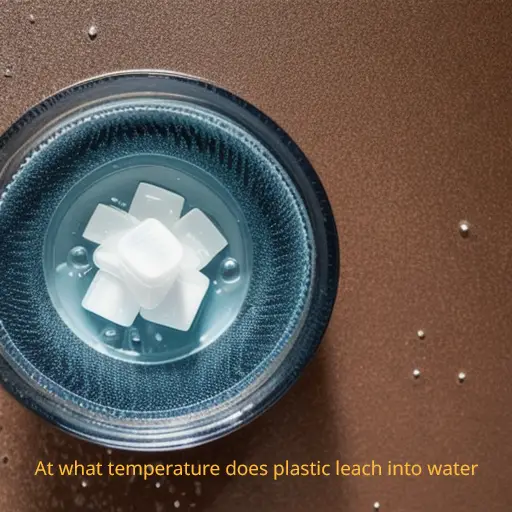Plastic is a material that is constantly present in our lives, but how much do we really know about it? One question that often comes up is: at what temperature does plastic leach into water? In this blog post, we will explore this topic and shed light on the process of plastic leaching, as well as the factors that can influence it. Understanding the temperature threshold at which plastic starts to break down and release chemicals into the water is crucial for making informed choices about the types of plastics we use and their potential impact on our health. So, let’s delve into the world of plastic leaching and discover the facts behind this intriguing phenomenon.
I.Understanding the potential risks of plastic leaching into water
Understanding the potential risks of plastic leaching into water
Plastic leaching refers to the process through which chemicals from plastic materials are released into the surrounding environment, including water. This poses potential risks to both human health and the environment. Plastic leaching can occur due to various factors including temperature, exposure time, and the type of plastic used.
When plastic comes into contact with water, especially at higher temperatures, the likelihood of leaching increases. Heat can cause the plastic to soften, which makes it easier for chemicals to migrate into the water. Additionally, prolonged exposure to high temperatures can accelerate the leaching process.
The type of plastic used also plays a role in leaching potential. Some plastics, such as polystyrene and PVC, have been found to leach more chemicals compared to others. It’s important to note that different chemicals can be released depending on the type of plastic, which can vary in their toxicity levels.
The temperature range at which plastic is more likely to leach into water varies depending on the type of plastic used. Generally, higher temperatures, such as those above 70 degrees Celsius (158 degrees Fahrenheit), increase the risk of leaching. However, it’s important to consider that lower temperatures can also lead to leaching, albeit at a slower rate.
The effects of different water temperatures on plastic leaching should be examined carefully. Studies have shown that the rate of leaching increases as temperatures rise, and this can have implications for human health, especially when consuming water with high levels of leached chemicals. The potential health risks associated with plastic leaching include endocrine disruption, developmental issues, and increased risk of certain diseases.
The environmental impact of plastic leaching cannot be overlooked. Plastic pollution resulting from leaching can harm aquatic ecosystems, affecting marine life and contaminating water sources. Additionally, plastic waste can persist in the environment for centuries, contributing to long-term pollution and ecological damage.
To reduce plastic leaching into water, it’s important to adopt measures such as using alternative materials, implementing proper waste management practices, and promoting recycling efforts. Conscious consumer choices, such as reducing single-use plastics and supporting sustainable packaging, can also contribute to mitigating the risks of plastic leaching into water.
In conclusion, understanding the potential risks of plastic leaching into water is crucial for addressing the issue of plastic pollution. By considering factors like temperature, type of plastic, and the effects on human health and the environment, we can take steps towards sustainable practices and minimize the impact of plastic leaching on our water sources.
II. What is leaching?
Explaining the process of leaching and its impact on water
Explaining the Process of Leaching and Its Impact on Water
Plastic leaching is the process by which chemicals present in plastic materials are released into surrounding liquids, such as water. This process occurs due to the nature of plastic and its chemical composition, which can interact with the liquid medium it comes into contact with. The impact of plastic leaching on water quality depends on various factors, including the type of plastic, temperature, and exposure time.
When plastic comes in contact with water, small amounts of chemicals, such as bisphenol A (BPA) or phthalates, can leach out. These chemicals are often used in the production of plastics to provide certain properties, such as flexibility and durability. However, they can have adverse effects on human health and the environment.
The impact of plastic leaching on water can be significant, as it can contaminate drinking water sources and aquatic ecosystems. The chemicals released during leaching can potentially disrupt hormonal balance, affect reproductive health, and even lead to the development of certain diseases. Moreover, these chemicals can also have detrimental effects on marine life and ecosystems when plastic waste ends up in the oceans or other bodies of water.
It’s worth noting that the temperature of the liquid can influence the rate at which plastic leaches. Higher temperatures can accelerate the leaching process, increasing the chances of chemical migration into the water. Therefore, it’s important to consider the temperature at which plastic is exposed to water, especially when dealing with food and beverage containers or when using plastic products in high-temperature environments.
To minimize the risks of plastic leaching into water, it’s advisable to use alternative materials, such as glass or stainless steel, for storing food and beverages. Additionally, reducing plastic waste through recycling and proper disposal can help prevent environmental contamination.
III. Factors affecting plastic leaching
Temperature and its role in plastic leaching
Temperature plays a significant role in the process of plastic leaching into water. When exposed to heat, plastic materials tend to release chemicals at a higher rate, leading to an increased risk of leaching. Different types of plastics have different temperature thresholds at which leaching becomes more likely.
Here are some key points regarding temperature and plastic leaching:
- Type of Plastic: The type of plastic used for packaging or containers determines its leaching potential. Certain plastics, such as polyethylene terephthalate (PET) and high-density polyethylene (HDPE), are considered to have lower leaching potential compared to polycarbonate (PC) or polyvinyl chloride (PVC).
- Temperature Range: Plastic leaching is more likely to occur at higher temperatures, especially above the typical room temperature. Studies have shown that as the temperature increases, the release of chemicals from plastic materials becomes more rapid.
- Effects of Water Temperature: The temperature of the water in contact with plastic can affect the leaching process. Hot or boiling water can accelerate the leaching of chemicals, while cold water may slow down the process.
- Potential Health Risks: The chemicals leaching from plastic, such as phthalates and bisphenol A (BPA), have been linked to potential health risks. These chemicals can act as endocrine disruptors and may have adverse effects on human health, especially with prolonged exposure.
- Environmental Impact: Plastic leaching into water bodies can have detrimental effects on aquatic ecosystems and wildlife. The chemicals released from plastics can contaminate the water, affecting the health and reproduction of aquatic organisms.
To minimize the risk of plastic leaching into water, it is important to consider using alternative materials such as glass or stainless steel for hot liquids or acidic beverages. Additionally, avoiding prolonged exposure to heat and using BPA-free or food-grade plastics can help reduce the potential for leaching.
The type of plastic and its leaching potential
The type of plastic used for containers and packaging plays a significant role in its potential to leach chemicals into water. Plastics are classified into different categories based on their chemical composition and properties. Some common types of plastics include polyethylene (PE), polypropylene (PP), polyvinyl chloride (PVC), polystyrene (PS), and polyethylene terephthalate (PET). Each type of plastic has unique characteristics that affect its leaching potential.
Here is a breakdown of some common plastic types and their leaching potential:
- Polyethylene (PE): This plastic is considered to have low leaching potential and is commonly used for water bottles and food containers.
- Polypropylene (PP): PP is also considered to have low leaching potential and is often used for food storage containers and microwave-safe dishes.
- Polyvinyl chloride (PVC): PVC has a higher leaching potential, especially when exposed to heat. It may contain phthalates and other additives that can migrate into water.
- Polystyrene (PS): PS is commonly used for disposable food containers and has a moderate leaching potential, especially when in contact with hot liquids.
- Polyethylene terephthalate (PET): PET is commonly used for beverage bottles and has a relatively low leaching potential. However, it is not recommended for reuse as repeated use can increase the risk of leaching.
It is important to note that the leaching potential of plastics can also be influenced by factors such as the quality of the plastic, the age of the product, and how it is stored and used. To minimize the risk of plastic leaching, it is advisable to choose food-grade plastics, avoid exposing plastics to high temperatures, and limit the reuse of single-use plastic containers.
IV. Which temperature does plastic leach into water?
Examining the temperature range at which plastic is more likely to leach into water
Plastic leaching refers to the process of chemicals from plastic materials seeping into the surrounding environment, potentially including water. While the temperature at which plastic starts to leach can vary depending on the type of plastic, studies have shown that higher temperatures can accelerate this process.
Different types of plastic have different leaching potentials, with some plastics being more susceptible to leaching than others. For example, plastic containers made from polyethylene terephthalate (PET), commonly used for packaging food and beverages, are known to release chemicals when exposed to high temperatures. On the other hand, plastics like high-density polyethylene (HDPE) and polypropylene (PP) tend to have a lower tendency to leach, even at higher temperatures.
The temperature range at which plastic is more likely to leach into water can vary depending on factors such as the type of plastic, contact time, and storage conditions. However, studies have suggested that temperatures above 100 degrees Fahrenheit (38 degrees Celsius) are more likely to accelerate the leaching process.
It’s important to note that the effects of plastic leaching into water can vary depending on the specific chemicals involved and their concentration. Some chemicals, such as phthalates and bisphenol A (BPA), have been linked to potential health risks such as endocrine disruption and reproductive problems.
To reduce the risk of plastic leaching into water, it is advisable to avoid exposing plastic containers to high temperatures, especially when used for food and beverages. Consider using alternatives such as glass, stainless steel, or BPA-free plastics for hot liquids. Additionally, proper storage and handling of plastic containers can also help minimize leaching.
Overall, understanding the potential risks of plastic leaching into water and taking proactive measures to reduce exposure can contribute to a healthier environment and promote sustainability.
V. The impact of hot and cold water on plastic leaching
Discussing the effects of different water temperatures on plastic leaching
Discussing the effects of different water temperatures on plastic leaching
The temperature of the water can have a significant impact on the leaching of plastic contaminants. When exposed to higher temperatures, plastics can release more chemical compounds into the water, increasing the potential health and environmental risks associated with plastic leaching.
Here are the effects of different water temperatures on plastic leaching:
- Increased leaching: Higher temperatures can accelerate the leaching process, causing plastic compounds to dissolve more readily into the water. This can result in higher levels of contaminants entering the water, posing greater risks to human health and aquatic ecosystems.
- Chemical reactions: Elevated water temperatures can cause chemical reactions within the plastic, leading to the breakdown of polymer chains and the release of harmful additives. These additives, such as bisphenol A (BPA) and phthalates, are known endocrine disruptors and can have negative effects on hormone regulation and reproductive health.
- Expansion and contraction: Temperature fluctuations can cause plastics to expand and contract, leading to microcracks and enhanced permeability. This allows water to penetrate the plastic more easily, facilitating the release of contaminants into the surrounding environment.
- Accelerated degradation: Heat can accelerate the degradation process of plastics, causing them to break down more quickly and release a higher concentration of hazardous substances. This degradation can result in the formation of microplastics, which can be ingested by marine organisms and potentially enter the food chain.
- Impact on aquatic life: Elevated water temperatures can affect the metabolism and behavior of aquatic organisms, making them more vulnerable to the toxic effects of plastic contaminants. Fish, in particular, may be affected by the release of plastic additives, leading to reproductive abnormalities and impaired immune function.
It is important to note that the specific type of plastic and its composition also play a significant role in the leaching process. Some plastics, such as polyethylene terephthalate (PET), have been found to leach fewer chemicals compared to others.
To mitigate the effects of plastic leaching, it is essential to reduce plastic consumption, choose plastic-free alternatives, and properly dispose of plastic waste. Additionally, using reusable water bottles and avoiding exposure to high temperatures can help minimize the leaching of plastic contaminants into water sources.
VI. Health and environmental concerns
The potential health risks associated with plastic leaching into water
The potential health risks associated with plastic leaching into water
Plastic leaching into water can pose various health risks, as it introduces potentially harmful chemical substances into the water that we consume or use for various purposes. These chemicals can be released from the plastic due to factors such as temperature, time, and the type of plastic involved. Here are some potential health risks associated with plastic leaching:
- Hormonal Disruption: Certain chemicals found in plastics, such as bisphenol A (BPA) and phthalates, have been linked to hormonal disruption. These chemicals can mimic or interfere with hormones in the body, potentially leading to developmental issues, reproductive problems, and increased risk of certain diseases.
- Cancer Risk: Some plastic additives, such as styrene and vinyl chloride, have been classified as possible or probable carcinogens. Prolonged exposure to these chemicals, especially through contaminated drinking water, may increase the risk of cancer, particularly in sensitive populations.
- Neurological Effects: Some studies suggest a possible link between certain plastic chemicals and neurological disorders, including cognitive impairments and behavioral changes. Chemicals like phthalates and brominated flame retardants have been associated with adverse neurological effects in animal studies.
- Immune System Dysfunction: Exposure to plastic chemicals may weaken the immune system, making individuals more susceptible to infections, allergies, and autoimmune disorders.
It is important to note that the levels of plastic leaching and associated health risks can depend on the specific plastic type, temperature, exposure duration, and individual susceptibility. While regulatory measures are in place to minimize risk, it is advisable to reduce plastic usage, opt for safer alternatives, and ensure proper water filtration or storage to minimize exposure to potentially harmful chemicals.
Environmental impact and consequences of plastic pollution
Plastic pollution has become a significant environmental issue, with detrimental consequences for ecosystems worldwide. The environmental impact of plastic is far-reaching and affects various aspects of the environment:
- Marine life: Plastic pollution poses a severe threat to marine life, as marine animals often mistake plastic debris for food or become entangled in it. This can lead to injuries, suffocation, and death. Additionally, plastic can disrupt marine ecosystems, alter habitats, and contribute to the decline of marine species.
- Water pollution: Plastic debris that ends up in water bodies can release harmful chemicals as it breaks down, contaminating the water and endangering aquatic organisms. The leaching of toxic substances from plastics can disrupt aquatic ecosystems and pose a risk to human health if consumed.
- Land degradation: Improper disposal of plastic waste can lead to land pollution, affecting soil fertility and contaminating groundwater. Plastic litter can also accumulate in natural habitats, such as forests and parks, degrading the visual appeal and biodiversity of these areas.
- Climate change: The production and disposal of plastic contribute to greenhouse gas emissions, primarily through the extraction and refinement of fossil fuels used in plastic manufacturing. Furthermore, the decomposition of plastic can release methane, a potent greenhouse gas.
- Microplastic contamination: Plastic debris can break down into tiny particles called microplastics, which can be ingested by organisms and enter the food chain. This poses a potential risk to human health when consuming contaminated seafood.
It is crucial to address plastic pollution through sustainable practices, such as reducing plastic consumption, promoting recycling initiatives, and developing eco-friendly alternatives. Collective efforts are necessary to mitigate the environmental consequences of plastic pollution and protect the Earth’s ecosystems.
VII. Preventing plastic leaching
Tips and measures to reduce plastic leaching into water
Reducing plastic leaching into water is crucial for safeguarding water quality and protecting human health. Here are some tips and measures that can help minimize plastic leaching:
- Avoid using single-use plastics: Opt for reusable alternatives such as stainless steel water bottles, glass containers, and cloth bags instead of disposable plastic bottles, bags, and food packaging.
- Use eco-friendly materials: Look for products made from materials like glass, ceramic, stainless steel, or natural fibers, which are less likely to leach chemicals into water compared to plastic.
- Choose wisely: When purchasing products, consider the packaging materials used. Look for items that use minimal or recyclable packaging.
- Proper storage: Store food and beverages in glass or stainless steel containers rather than plastic containers, especially when exposed to heat or prolonged contact.
- Improve water quality: Use water filters or purifiers to remove contaminants from tap water. This can reduce the need for plastic water bottles.
- Recycle: Properly recycle plastic waste to prevent it from ending up in landfills or water bodies, where it can contribute to leaching.
- Support legislation and initiatives: Advocate for policies that promote the reduction of plastic pollution and support initiatives that focus on sustainable alternatives.
- Educate and raise awareness: Share information on the risks of plastic leaching into water with friends, family, and your community. Encourage them to adopt sustainable practices and reduce plastic use.
- Choose BPA-free products: Bisphenol A (BPA) is a chemical commonly found in plastic containers and can leach into water. Look for products labeled as BPA-free.
By implementing these measures, individuals can contribute to reducing plastic leaching into water and promote a healthier environment. It is important to remember that every small effort counts and can make a significant impact over time.
VIII. Conclusion
Summarizing the key points and effects of plastic leaching into water
In summary, plastic leaching into water can have significant effects on both human health and the environment. Here are the key points to consider:
- Leaching process: Plastic leaching refers to the release of chemicals from plastic materials into the surrounding water. This process can occur due to various factors such as temperature, contact time, and the type of plastic.
- Temperature impact: Higher temperatures can accelerate the leaching process, causing more chemicals to be released into the water. However, the specific temperature range at which plastic leaches varies depending on the type of plastic.
- Type of plastic: Different types of plastic have different leaching potentials. For example, plastics labeled with recycling codes 3, 6, and 7 are more likely to leach harmful chemicals compared to those labeled with codes 1, 2, 4, and 5.
- Health risks: Plastic leaching can introduce harmful chemicals such as phthalates and bisphenol A (BPA) into the water. These chemicals have been linked to various health issues, including hormonal disruptions, developmental problems in children, and an increased risk of certain diseases.
- Environmental impact: Plastic leaching contributes to plastic pollution in water bodies, which poses risks to aquatic life. Animals can mistake plastic particles for food, leading to ingestion and entanglement.
- Prevention and reduction: To minimize the leaching of plastic into water, it is important to use safe and eco-friendly alternatives to plastic, properly dispose of plastic waste, and avoid exposing plastic to high temperatures whenever possible.
Overall, understanding the risks and taking proactive steps to minimize plastic leaching into water is crucial for safeguarding human health and protecting the environment.




